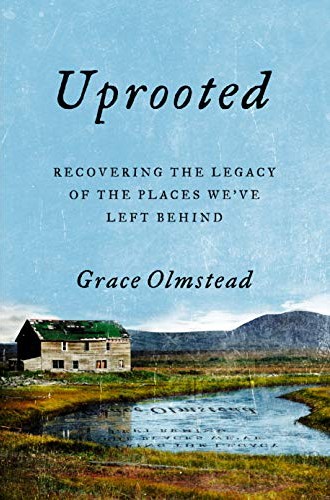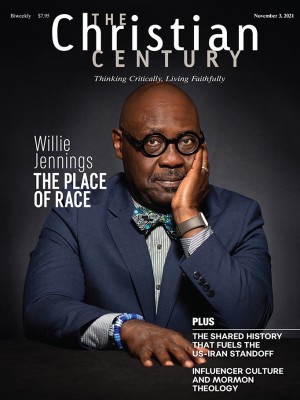The stickers and boomers of Idaho’s Treasure Valley
Grace Olmstead has written a reverent ode to those who stick around.

Uprooted
Recovering the Legacy of the Places We’ve Left Behind
On the way to church each week I pass the Great American Neighborhood. It’s one of at least five developments in my area living under that registered trademark. The development company says it builds “places as special as the people who live in them.” It’s a fascinating notion, customizing a place to folks who are not yet there, and one so pretentious that only late capitalism could have dreamed it up. We want everything—even the cornfield to which we have not yet moved—to speak our name.
At the center of journalist Grace Olmstead’s new book is the kind of town this development (with its summer movie nights, “shared spaces to be enjoyed with neighbors and friends,” and “sense of timelessness”) feigns to be. Uprooted is an inquiry into a farming community and the lives of those the novelist Wallace Stegner calls “stickers,” or people who commit to a place, as well as their antithesis, “boomers,” those who move to a place until it suits them to leave. Olmstead describes Stegner’s archetypes thusly: “Stickers are those who settle down and invest. Boomers come to extract value from a place and then leave.”
Read our latest issue or browse back issues.
Uprooted serves as a reverent ode to stickers—in particular, those in Emmett, Idaho, a farm town where Olmstead’s family lived for generations and which serves as the beating heart of her project. It’s a place of cherry orchards and dairy farms, fields of sugar beets and alfalfa—and, increasingly, a place spun dry by the centrifugal forces of modernity. Like Wendell Berry writes of Port William, the fictional town at the center of much of his fiction, Emmett is “the sort of place that pretentious or ambitious people were inclined to leave.”
Stegner’s binary is one to which Olmstead returns throughout the book, although she complicates it by musing also about the stuck: those who don’t have enough resources to move away. I wonder as well about the pushed and the brought: indigenous populations and enslaved people. And isn’t sticker sometimes just another word for settler? Still, it’s an illuminating frame, as far as “two kinds of people in the world” heuristics go.
Olmstead’s great-grandparents, Grandpa Dad and Grandma Mom, were stickers, she says, who had less than five dollars when they moved into their first house. They helped build roads around Emmett, dug irrigation ditches, and cared for their neighbors during hard times. They put more into the land and the people than they took out, and they become the heroes of Olmstead’s narrative. “The more I studied the history of my own community, the more I realized that most of its struggles with depletion and brokenness were caused by those who leave,” she writes. “The only times things were mended and restored were the times when someone, somewhere, chose to stay.”
Stickers like her great-grandparents defy the siren song of educational and career advancement, social mobility, and a good sushi bar on the corner. Meanwhile, those who leave places too provincial to handle their ambition—the boomers—tend to look askance at those who stay put.
After doing interviews at the local high school, Olmstead writes, she figures out that a lot of students “don’t seem to have any concrete plans for exodus, just a sense that it’s good to say you have big plans.” Ironically enough, those with big plans often end up in places that simulate the places they’ve left behind. The Great American Neighborhood is designed to make booming look and feel like sticking.
Uprooted joins books like Sarah Smarsh’s Heartland and Marie Mockett’s American Harvest in offering up portraits of rural America that both dignify and diagnose. It is at once an elegy for an agricultural way of life Olmstead fears is no longer possible and an indictment of the forces that brought us here.
Culprits include agribusiness and the cash subsidies that sustain it, biotechnology that depletes the soil in the name of production, proprietary seed sales, suburban development and the ensuing loss of local food systems, capitalism’s perpetual drive toward profit, and widespread illusions that the smartest people are the most mobile and least dirty. “This valley’s transformation over the past two centuries has not been the benign work of an invisible hand,” Olmstead writes. “It was the result of deliberate choices to maximize profit rather than embrace limits.”
Olmstead mourns the weakening social capital that has us increasingly bowling alone. Many communities in flyover country are increasingly “empty of people and of hope,” she writes. No matter one’s allegiance to a place like Emmett, leaving begins to make its own kind of sense. The author herself moved to the East Coast for college, got married, had kids, and settled down. Throughout the book she perseverates over having left, and the question of whether she should go back to Emmett, to become part of the solution to the manifold problems of rural America, sits at the center of the project.
It’s a unique and increasingly rare dilemma—how many people have a sense of a home to which to return, let alone the option of returning there? Within Olmstead’s privileged conundrum, however, is a quintessentially modern question: Do I belong to the place where I live, or do I move to the place where I will belong?
The biggest risk in a book like Uprooted, written by a White writer, is nostalgia for a rural idyll that never existed—“the way we never were,” as historian Stephanie Coontz puts it. At times Olmstead seems aware of that romanticizing impulse. She narrates the plight of Black farmers, Japanese immigrants, and other migrants to Idaho in centuries past who were chased away by policy and prejudice. And she summarizes the contemporary realities of undocumented farmworkers, including low wages, lack of labor protections, maltreatment by employers, and pesticide poisoning.
Olmstead doesn’t feature any of their stories, however, and at points she appears unaware of the racialized nature of nostalgia for the heartland—failing to mention Donald Trump, for example, until three-quarters of the way through the book. Whether that is an admirable show of writerly restraint or a White woman’s prim avoidance of the nasty politics that could confirm suspicions about her people is open to debate. But ultimately, in a 2021 book about rural places inhabited mostly by White people, can you in good conscience wait that long to talk about Trump?
At its best, however, Olmstead’s prose manages to be both lyrical and investigative. She is a keen observer of places and people, and she serves as a thoughtful and informed tour guide of her hometown and the people who still populate it. She explains complicated agricultural realities well, and she narrates her encounters with the locals of Emmett with vivid description.
We meet farmers like Matt Williams, the owner of Waterwheel Gardens, which grows “a little of a lot of things” and sells produce in nearby cities. “Everything about Waterwheel Gardens is antithetical to the large, specialized monocropping model” that reigns in the United States, she writes, and if there’s any answer to the problems she identifies in Uprooted, this type of diversified farm gets close to solving it.
There’s an ominous note to Olmstead’s book, one that any honest treatment of land and community must include in 2021. Climate change, the loss of acreage to suburban malls and developments, and the fraying social fabric of small communities are only intensifying. Even the Williams farm, which serves mostly as evidence of hope in her investigation, was purchased before the real estate boom that now has the Boise exurbs creeping toward her hometown. Whether anyone planning to do small-scale, labor-intensive farming, like the Williams family, could afford to buy land around Emmett today is severely in doubt.
So nostalgia of a certain kind is not entirely misplaced. Unless local planners implement strategies of land preservation, Olmstead claims, “newcomers to this land could eliminate the very ‘foodscape’ their presence demands.” She cites one study that suggests that Treasure Valley, where her hometown is located, “could lose between 59 percent and 64 percent of its farmland by 2100.”
Still, what Olmstead calls “quiet legacies of faithfulness” persist in Emmett. She finds hope in the steadfastness and commitment of the farmers she interviews, who live out virtues of constancy, hard work, thrift, and fidelity to community and land despite pressures from all sides.
During the time I was reading Uprooted, I attended the memorial service for a friend’s father, who had served as a doctor in a rural county in Pennsylvania. The stories people told about Doc, as he was known—from cross-country skiing across a field in a storm to see a patient, to practicing with his barbershop quartet on Thursdays, to bringing along his whole family to interview a young colleague—spoke of a man deeply committed to a place.
Sitting in a folding chair in a community center and listening to Doc’s friends remember his life, I marveled at the frequency with which the word we was spoken—the sense of belonging expressed over and over again. There was no trademark here, no simulacra. I thought, too, of Wallace Stegner’s words—that boomers are those who “pillage and run,” while stickers are “those who settle, and love the life they have made and the place they have made it in.” Doc planted deep roots in that small Pennsylvania town, just as Olmstead’s people did in Emmett, clearly loving the life he had made and the place in which he made it.
Yet in reality, none of us is either a boomer or a sticker. Or perhaps we are both. Doc didn’t pillage, but he did eventually run, leaving town to start a new family and a new practice several states away. Olmstead left too, although she describes habits of rootedness she has taken with her from Emmett. And the new residents of that erstwhile cornfield who apparently long to be stickers: who’s to say ersatz, corporate-brokered community won’t someday lead to the real thing?
So I am not ready to assent to Stegner’s binary, no matter how neatly Olmstead’s great-grandparents fit within it. Leaving a place does not mean extraction is happening, and staying put doesn’t mean it isn’t. Organic farmers often move to places they’ve never lived, and real estate developers’ roots sometimes sink generations deep into the very soil systems their bulldozers destroy.
Stegner himself concedes that an “extractive frenzy” can fall upon even the most earnest stickers, who must learn to resist it. Ideally the local church becomes salient at this juncture, nurturing within us commitments to God and place and people that can stave off the extractive frenzies of our age. In my ideal world, my congregation helps me tamp down my impulses to extract and commodify. In my real world, the developer is leading worship.
We’re left, then, with the contradictions Kathleen Norris identified in Lemmon, South Dakota, where her mother grew up and where she wrote Dakota—between “hospitality and insularity, change and inertia, stability and instability, possibility and limitation, between hope and despair, between open hearts and closed minds.” We’re left with the truth that we can root or uproot, enrich or extract, and must daily hone our instincts toward the former.
A version of this article appears in the print edition under the title “Stickers and boomers.”





